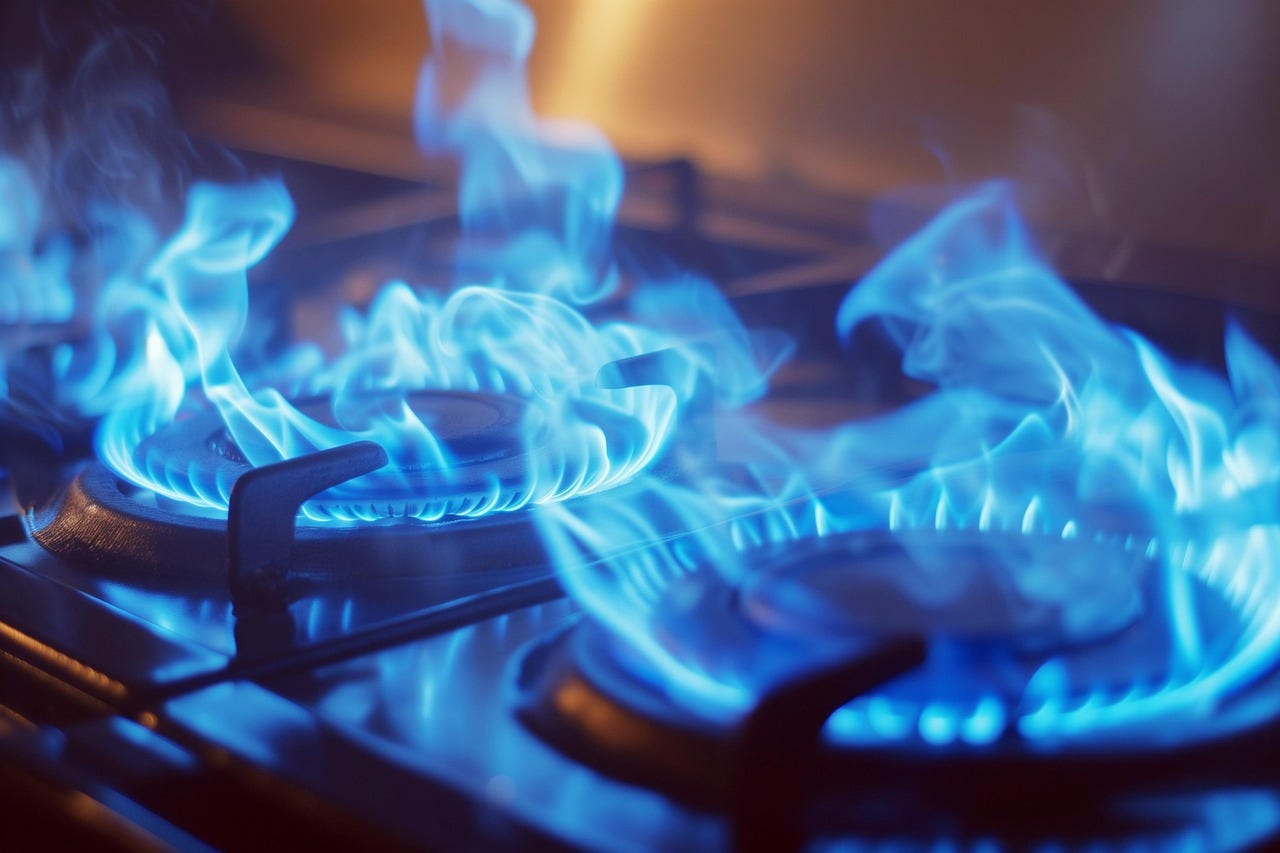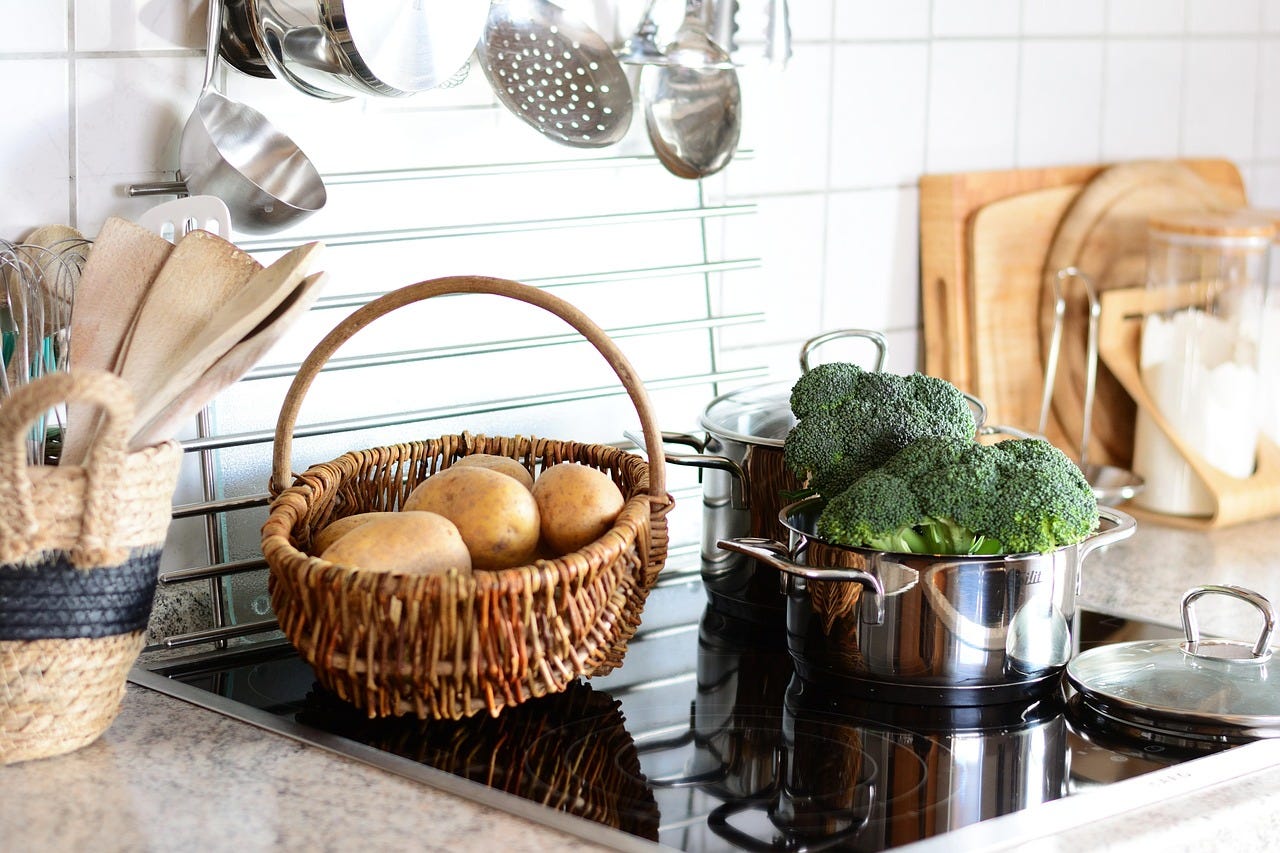Induction or Gas? Why this change in your kitchen pays off
Cooking on an induction stove is healthier. For your family. And for the planet. But gas stoves are part of our food culture. How does it feel to make the switch?
When was the last time you cooked with all the windows and doors open? I’m asking because air quality is an underdiscussed aspect of cooking. Especially when cooking on a gas stove. But does switching to an electric appliance mean you have to sacrifice the pleasure of cooking (with gas), or the quality of your meals? This month’s newsletters will take a closer look at induction stoves.
New here? Every month, Climate Culinarians picks one topic and publishes a series of newsletters about it, ending with a recipe (see the weekly structure here). This month will be all about stoves. Subscribe to never miss a new post!
How gas stoves threaten your family’s health
The warming season makes me chuckle at a slapstick memory from the kitchen: Me battling with a large, portable ventilator on sweltering summer days. I wanted my stove’s flames to reach the pot. At the same time, I needed a breeze so I wouldn’t melt. The flames insisted it’s either-or. And mostly, my gas stove won. Little did I know that the main threat was not heat exhaustion.

In 2022, the American Public Health Association issued a statement calling gas cooking stoves a public health concern (read the full report behind the statement here). Why? People in households using gas stoves breathe in several pollutants, among them these two:
nitrogen dioxide (NO2) - causes or exarcabates respiratory problems like asthma
methane from unburned gas - a potent greenhouse gas
Nitrogene dioxide has been found the most concerning health hazard from gas stoves.
NO2 can cause or exarcabate respiratory problems, expecially in children, old people, and those with pre-existing conditions. In other words: When you cook with a gas stove, you raise the risk of your children developing asthma. Within an hour of cooking, Stanford scientists found nitrogen dioxide even in bedrooms far away from the kitchen (read about this study here).
Why ditching a gas stove is climate action
Another reason to stop cooking with gas: climate change. Methane is climate-altering pollution, also known as a greenhouse gas. Methane also is the main component of the gas Americans call “natural gas”. It’s what a gas stove burns as fuel. And it leaks from gas stoves, even when not in use, as a small study in California showed. It also leaks from pipelines that carry methane across the country. Oh, and methane can explode (read more about gas stove risks at ProPublica).
When it comes to turning the earth’s atmosphere into a heat trap, methane is about 80 times more efficient (over 20 years) than carbon dioxide. And while carbon may linger for hundreds of years, methane leaves the atmosphere within about 7-12 years. So we should feel the positive effects pretty fast if we reduce our methane output. Like finding another fuel for cooking.
What do a cooking pro and a foodie say about gas versus induction?
Okay, until now I’ve sticked to reason. But cooking is not just science. In U.S. food culture, gas stoves are everywhere. Just go and look for an image of cooking on a stove: You’ll see flames. Mostly blue. How does it feel to leave those methane-fueled flames behind?

I asked
, author of the cookbook Zero Waste Kitchen (make sure you check out her newsletter!). She switched from a gas stove to an induction stove in 2023. At the time, her blog left little to the imagination how she felt about her new appliance. “If my new induction electric range were a man, I’d marry it”, she wrote. As a headline, no less (read her whole post here).Well, that was two years ago. I’m sure that by now, the reality of her almost marriage to an induction stove has set in. So I caught up with Bonneau via email. “Oh I still love, love, love my stove, nearly two years on”, she wrote back. “I really have no complaints and wish I had made the switch sooner.”
Have you tried cooking on an induction stove? Or would you rather stick to gas?
How does an induction stove work?
An induction stove
is powered by electricity,
works through magnetism
and directly heats the metal in your pot or pan.
Right under the glass or ceramic surface, there are copper coils. They create an electromagnetic field. Which leads to a current moving through your cookware’s metal. And here comes the heat:

The magnetic field induces currents that are called eddy currents. They move like eddies in a river: swirling, circular, and really fast. Like big boulders in that river, your cookware resists the current. And when a current runs into resistance within metal (not a river), it creates heat.
Induction stoves are more energy-efficient than gas stoves. Because the induction method directly heats the pot. Nothing else.
What a difference to putting a pot over a hot flame that heats the air and the cooktop, too. And yes, induction cooktops warm up, too. They pick up heat that is radiating back from your pot to the glass or ceramic surface.
Talking about surface: I did not believe what they said about those smooth cooktops.

I made the switch to an induction range at about the same time as Anne-Marie Bonneau. For me, it was a culture shock. When my new range arrived, I took one look at its immaculate, shiny cooktop and flinched. How long until this is ruined?
I was terrified. I pointed out the cooktop’s look to an unnamed member of my household who is known for splash fests rather than gentle cooking. Now they were also terrified (of me). Two years on, I agree with Zero Waste Kitchen chef Bonneau.
“I really appreciate how easily it cleans up with a wipe of a damp cloth”, she writes when I ask about how the first two years with an induction stove have been. “My stovetop now always looks clean. It didn’t back when we had a gas range.”
That said, I’m sure you can ruin the surface if you really try. Just don’t do it in my kitchen.
Okay, I’m assuming deliberate destruction is not a major problem. But induction stoves are not as flawless as their shiny surfaces, and there are things to consider. That’s why next week’s newsletter will discuss
what the switch to induction requires from a home chef (again with tips from Anne-Marie Bonneau!),
how switching to healthier, more climate-friendly cooking is doable for renters,
and why induction stoves will humble chefs who cook James Bond style.
And if you’re wondering what James Bond-style cooking even is, well, think of martinis and … no, you’ll have to wait and see.
Read, eat, repeat!
Petrina
Climate Culinarians is a project by me, Petrina Engelke. I write about climate, food and the U.S., and I help other writers turn their ideas into a book people want to read. In other words: I’m a journalist and a book coach. Read more about this newsletter & me here.


